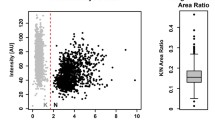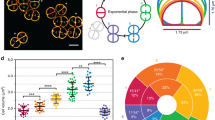Summary
We investigated the manner of mitochondrial DNA (mtDNA) replication and distribution during the culture ofPhysarum polycephalum amoebae cells by microphotometry, anti-BrdU immunofluorescence microscopy, and quantitative hybridization analysis. In amoebae cells ofP. polycephalum, the number of mitochondria per cell and the shape of both mitochondria and mitochondrial nuclei (mt-nuclei) noticeably changed over the culture period. At the time of transfer, about 27 short ellipsoidal shaped mitochondria, which each contained a small amount of DNA, were observed in each cell. The number of mitochondria per cell decreased gradually, while the amount of mtDNA in an mt-nucleus and the length of mt-nuclei increased gradually. Midway through the middle logarithmic growth phase, the number of mitochondria per cell reached a minimum (about 10 mitochondria per cell), but most mtnuclei assumed an elongated shape and contained a large amount of mtDNA. During the late log- and stationary-growth phase, the number of mitochondria per cell increased gradually, while the amount of DNA in an mt-nucleus and mt-nuclei length decreased gradually. Upon completion of the stationary phase, the number and condition of mitochondria within cells returned to that first observed at the time of transfer. The total amount of mtDNA in a cell increased about 1.6-fold the first day, decreased immediately, then maintained a constant level ranging from 130 to 160 T. Except for the fact that mtDNA synthesis began earlier than synthesis of cell nuclei, the rate of increase in mtDNA paralleled that of cell-nuclear DNA throughout the culture. These results indicate that mtDNA is continuously replicated in pace with cell proliferation and the rate of mitochondrial division varies during culture; this mitochondrial division does not synchronize with either mtDNA replication or cell division. Furthermore, we observed the spatial distribution of DNA replication sites along mt-nuclei. Replication began at several sites scattered along an mt-nucleus, and the number of replication sites increased as the length of mt-nuclei increased. These results indicate that mtDNA replication progresses in adjacent replicons, which are collectively termed a mitochondrial replicon cluster.
Similar content being viewed by others
Abbreviations
- DAPI:
-
4′,6-diamidino-2-phenylindole
- VIMPCS:
-
video-intensified microscope photon counting system
- BrdU:
-
5-bromodeoxyuridine
- FITC:
-
fluorescein isothiocyanate
References
Dee J (1986) The culture ofPhysarum amoebae in axenic media. In: Dove WF, Dee J, Hatano S, Haugli FB, Wohlfarth-Bottermann K-E (eds) The molecular biology ofPhysarum polycephalum. Plenum, New York, pp 253–269
—, Foxon JL, Anderson RW (1989) Growth, development and genetic characteristics ofPhysarum polycephalum amoebae able to grow in liquid, axenic medium. J Gen Microbiol 135: 1567–1588
Freifelder D (1970) Molecular weights of coliphage DNA. IV. Molecular weights of DNA from bacteriophages T 4, T 5 and T 7 and the general problem of determination of M. J Mol Biol 54: 567–577
Fry J, Matthews HR (1987) Flow cytometry of the differentiation ofPhysarum polycephalum myxamoebae to cysts. Exp Cell Res 168: 173–181
Grimes GW, Mahler HR, Perlman PS (1974) Nuclear gene dosage effects on mitochondrial mass and DNA. J Cell Biol 61: 565–574
Hand R (1978) Eucaryotic DNA: organization of the genome for replication. Cell 15: 317–325
Kawano S, Nishibayashi S, Shiraishi N, Miyahara M, Kuroiwa T (1983) Variance of ploidy in mitochondrial nucleus during spherulation inPhysarum polycephalum. Exp Cell Res 149: 359–373
Kolb-Bachofen V, Vogell W (1975) Mitochondrial proliferation in synchronized cells ofTetrahymena pyriformis. Exp Cell Res 94: 95–105
Kuroiwa T (1982) Mitochondrial nuclei. Int Rev Cytol 75: 1–59
—, Hizume M, Kawano S (1978) Studies on mitochondrial structure and function inPhysarum polycephalum IV. Mitochondrial division cycle. Cytologia 43: 119–136
—, Miyamura S, Kawano S, Hizume M, Thoe A, Miyakawa I, Sando N (1986) Cytological characterization of NOR in the bivalent ofSaccharomyces cerevisiae. Exp Cell Res 165: 199–206
Manders EMM, Stap J, Brakenhoff GJ, Van Driel R, Aten JA (1992) Dynamics of three dimensional replication patterns during the S-phase, analysed by double labelling of DNA and confocal microscopy. J Cell Sci 103: 857–862
Munaut C, Dombrowicz D, Matagne RF (1990) Detection of chloroplast DNA by using fluorescent monoclonal anti-bromodeoxyuridine antibody and analysis of its fate during zygote formation inChlamydomonas reinhardtii. Curr Genet 18: 259–263
Parsons JA, Rustad RC (1968) The distribution of DNA among dividing mitochondriaTetrahymena pyriformis. J Cell Biol 37: 663–693
Pica-Mattoccia L, Attardi G (1972) Expression of the mitochondrial genome in HeLa cells IX. Replication of mitochondrial DNA in relationship to the cell cycle in HeLa cells. J Mol Biol 64: 465–484
Posakony JW, England JM, Attardi G (1975) Morphological heterogeneity of HeLa cell mitochondria visualized by a modified diaminobenzidine staining technique. J Cell Sci 19: 315–329
Sambrook J, Fritsch EF, Maniatis T (1989) Molecular cloning: a laboratory manual, 2nd edn. Cold Spring Harbor Laboratory, Cold Spring Harbor
Satoh M, Nemoto Y, Kawano S, Nagata T, Hirokawa H, Kuroiwa T (1993) Organization of heterogeneous mitochondrial DNA molecules in mitochondrial nuclei of cultured tobacco cells. Protoplasma 175: 112–120
Stevens BJ (1977) Variation in number and volume of the mitochondria in yeast according to growth conditions. A study based on serial sectioning and computer graphics reconstitution. Biol Cell 28: 37–56
Suzuki T, Kawano S, Sakai A, Fujie M, Kuroiwa H, Nakamura H, Kuroiwa T (1992) Preferential mitochondrial and plastid DNA synthesis before multiple cell divisions inNicotiana tabacum. J Cell Sci 103: 831–837
- Sasaki N, Sakai A, Kawano S, Kuroiwa T (1994) Preferential synthesis of organelle DNA in the root apical meristem. J Exp Bot (in press)
Takano H, Kawano S, Suyama Y, Kuroiwa T (1990) Restriction map the mitochondrial DNA of the true slime mould,Physarum polycephalum: linear form and long tandem duplication. Curr Genet 18: 125–131
Wells JRM (1974) Mitochondrial DNA synthesis during the cell cycle ofSaccharomyces cerevisiae. Exp Cell Res 85: 278–286
Author information
Authors and Affiliations
Rights and permissions
About this article
Cite this article
Sasaki, N., Suzuki, T., Ohta, T. et al. Behavior of mitochondria and their nuclei during amoebae cell proliferation inPhysarum polycephalum . Protoplasma 182, 115–125 (1994). https://doi.org/10.1007/BF01403473
Received:
Accepted:
Issue Date:
DOI: https://doi.org/10.1007/BF01403473




